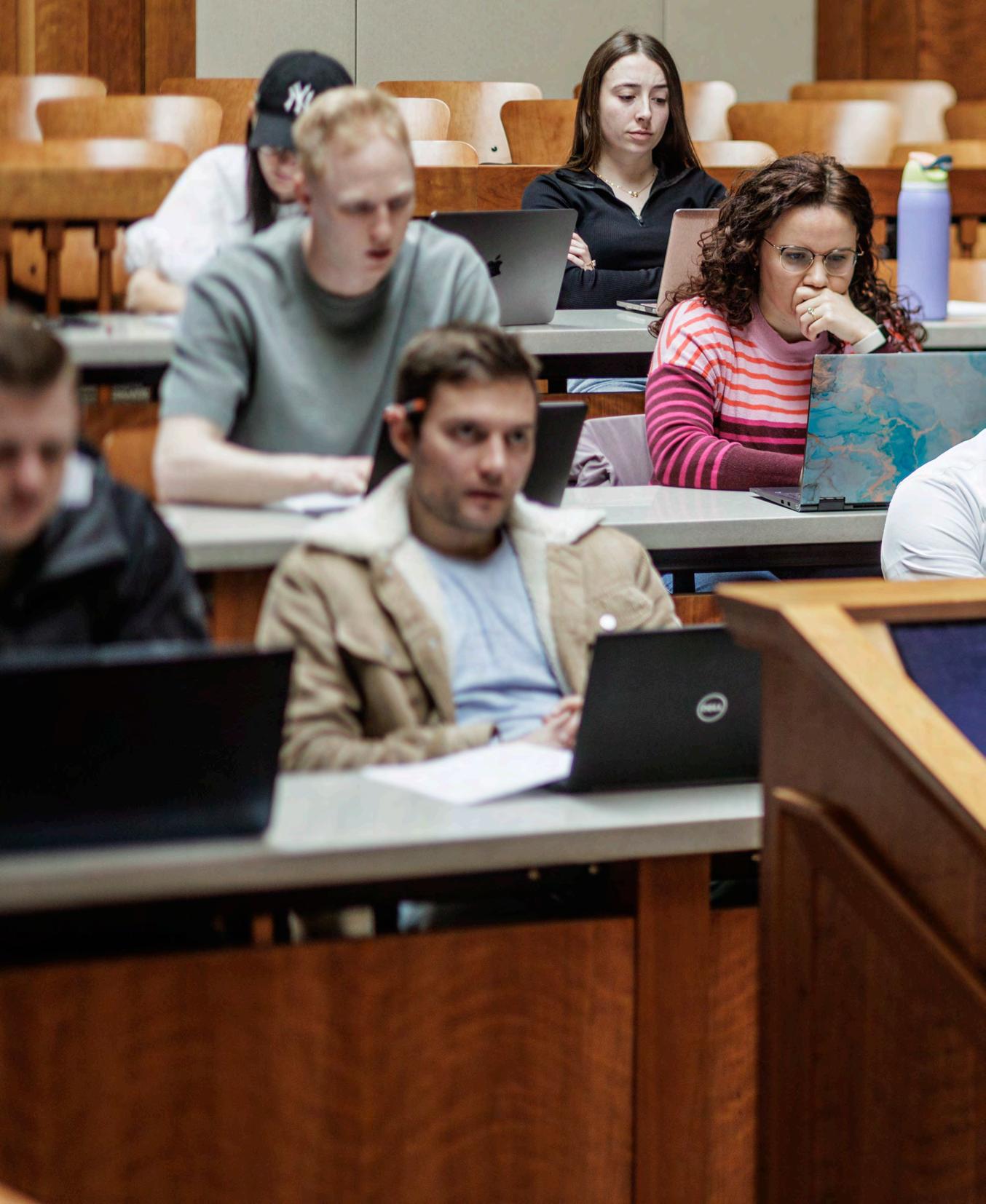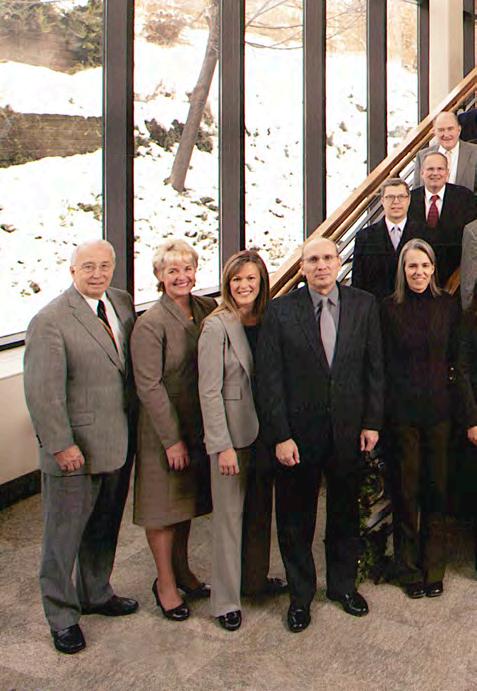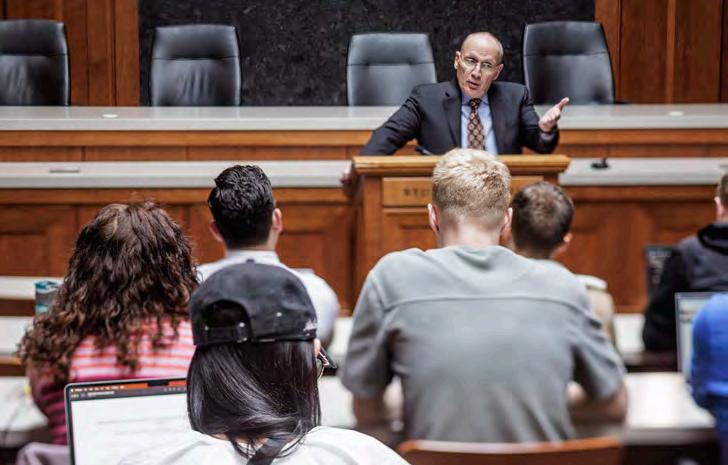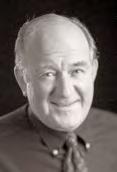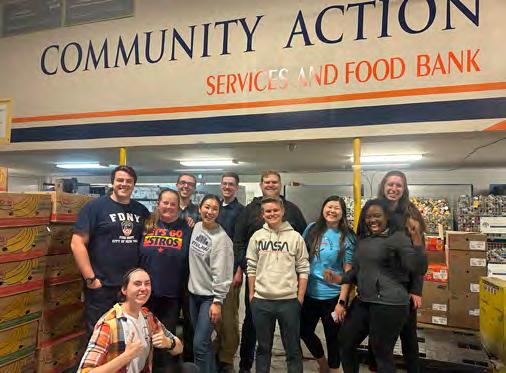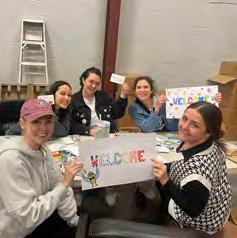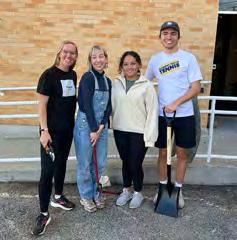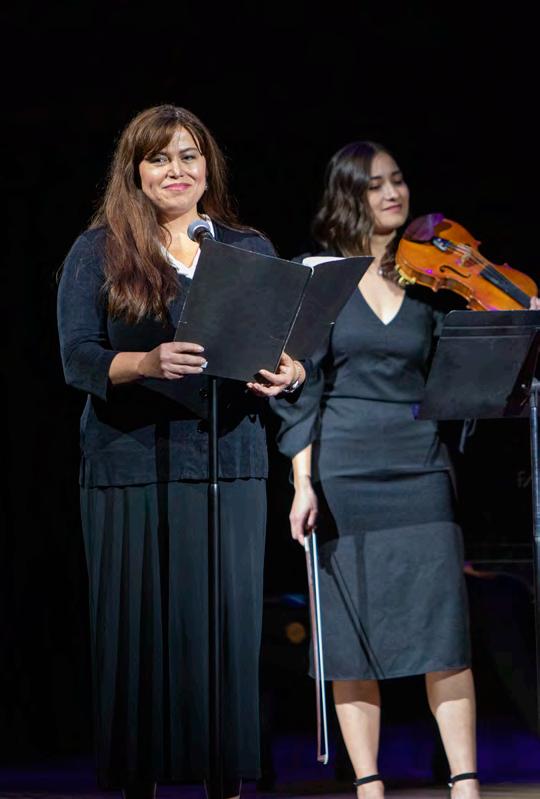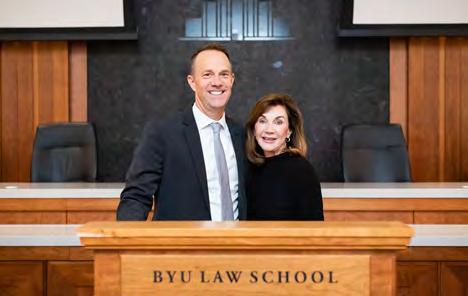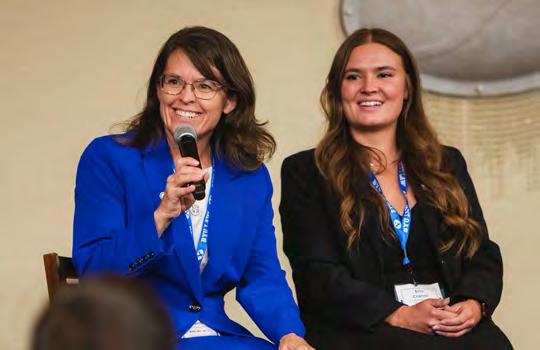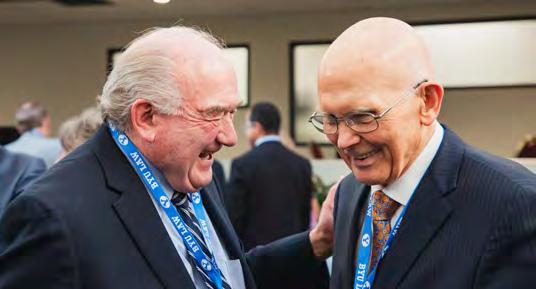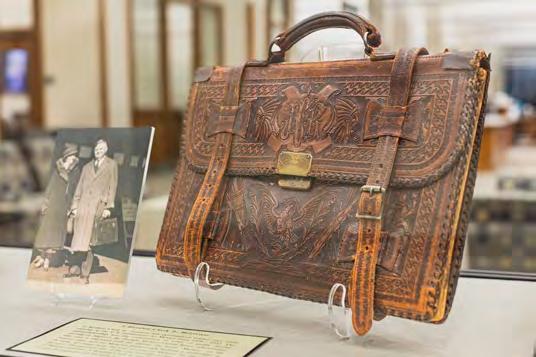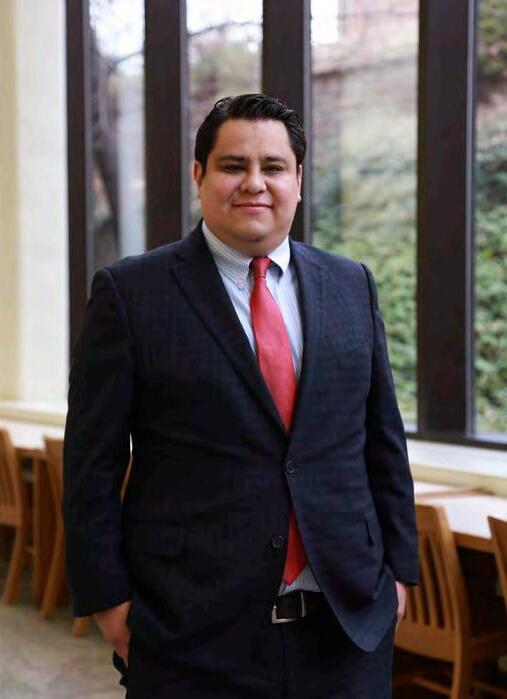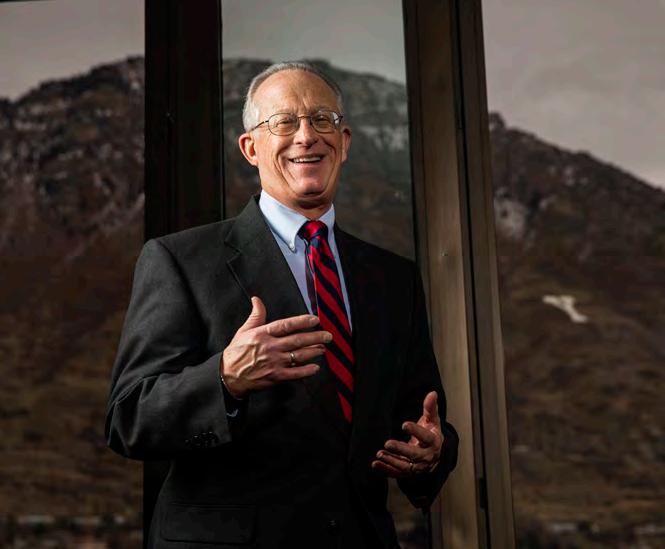





What shall it profit a man, if he shall gain the whole world, and lose his own soul?” 1 With this question, the Savior invites us to examine the priorities we pursue. Are we chasing losing bargains? As the Savior taught, what some perceive as profitable can be devastating; winning can mean losing.

Legal education and a legal career can profit us much. My legal education and career have improved my abilities to analyze, understand, speak, write, advocate, and lead. My life in the law has yielded fascinating experiences, a broader worldview, opportunities to bless others, valued friendships, and a stable livelihood. Of course, life in the law can also offer bad bargains. The lure of power, prestige, and possessions can corrupt character and behavior. Whether in school or in practice, life in the law can also be demanding, making it easy to get lost in the next exam, billable hour, transaction, or hearing. What is at stake in mortality is far greater than all these concerns. All that the Father hath is on the line.2
Fortunately, achieving that eternal reward does not require abandoning the law. Indeed, success in mortality turns on the law—the law we choose to live. As President Russell M. Nelson has taught, “During this life we get to choose which laws we are willing to obey—those of the celestial kingdom, or the terrestrial, or the telestial—and, therefore, in which kingdom of glory we will live forever.”3 The law we live determines our destiny.
byu Law is uniquely committed to combining the benefits of a legal education and career with a commitment to celestial law. As faculty, staff, students, and graduates, “we seek to be and develop people of integrity who combine faith and intellect in lifelong service to God and neighbor.”4 This issue of the Clark Memorandum shares remarks delivered by several of our outstanding faculty who are both exemplary scholars and dedicated disciples.
I do not know whether there will be a need for lawyers in the celestial kingdom, but this world needs lawyers who live celestial laws—lawyers who excel at their craft with civility, honesty, compassion, humility, and selflessness. Lawyers who are also covenant disciples. Such lawyers pursue the double aim of reaching for their eternal potential while blessing the profession and their communities now. That is a profitable path.
notes
1 Mark 8:36.
2 See Doctrine and Covenants 84:38.
3 Russell M. Nelson, “Choices for Eternity,” worldwide devotional for young adults, May 15, 2022, churchofjesuschrist .org/study/broadcasts/worldwide-devotional-for-young -adults/2022/05/12nelson.
4 “Mission and Objectives,” byu Law School, law.byu.edu /about/mission-and-objectives.

e have all kinds of things to be afraid of. Just turn on the news. The detailed reports of atrocious murders, rioting, rampant worldwide diseases, school shootings, suicides, bitterness between rivaling political parties, issues that split and divide the country, the chaos created by malware and ransomware, threats on financial security, and the advent of new types of fraud seems endless. Listening to the news can be scary and exhausting. ¢ The question I address today is “How we can face our fears with faith?” ¢ I will be forever grateful to the Young Women leader who asked me to make a poster of the scripture from 2 Timothy 1: “For God hath not given us the spirit of fear; but of power, and of love, and of a sound mind.”1 As I carefully outlined the letters to get it just right, I had plenty of time to have these words sink deeply into my young heart. This is a scripture I continue to rely on for one simple reason: I am prone to fear. During stressful times, I repeat my mantra: “Power, love, strong mind. Power, love, strong mind.”
This article is adapted from remarks delivered at byu Law’s devotional on December 6, 2023.

This is what the Lord gives us: power, love, and a strong mind. In my experience, fear does not come from the Lord. Sometimes fear is inherent in the situations we find ourselves in, but if we are living in alignment with gospel principles, fear never comes from the Lord.
I want to share lessons I’ve learned about how power, love, and a strong mind can help us overcome fear.
Understanding Our Unique Mission Gives Us Power
I have learned that understanding our individual missions gives us great power to conquer our fears. The story of Esther illustrates this power.2
King Ahasu erus of Persia had a favorite prince, Haman, who was angered that Mordecai would not bow to him. Mordecai was an observant Jew who would only bow to his God. Haman convinced the king to sign a decree requiring the destruction of the Jews. When Mordecai learned of this decree, he gave it to the king’s chamberlain with the instruction to deliver it to Esther, for Mordecai had been her guardian and she was now the wife of the king. Mordecai “[charged] her that she should go in unto the king, to make supplication unto him, and to make request before him for her people.”3
I can imagine how devastated Esther must have been when she read that decree signed by her husband. She had been keeping her Jewish identity a secret from the king, an identity she now understood could get her killed. Additionally, on penalty of death, no one could approach the king unless summoned. In my mind, Esther’s initial response sounded something like, “I can’t approach the king. I haven’t even seen the king in 30 days, and I’m not sure if I’m in favor with him. And this isn’t a subject I can casually mix into the conversation were I to see him.”
Mordecai, however, sees what can be done. His answer to Esther, and I continue to paraphrase, was “If you hold your peace at this time, then the deliverance of the Jews will arise from another place.” Are you astonished at his great faith? We don’t often emphasize the great faith of Mordecai when telling this story. He was there when Esther was chosen to be one who would spend a
year preparing to meet the king, and I’m guessing he understood that she landed in her position not out of random luck or just because she was beautiful. I believe that Mordecai was one who saw the hand of God in all things. Mordecai understood that Esther had a mission.
When Mordecai asked the famous question, “Who knoweth whether thou art come to the kingdom for such a time as this?”4 it was no casual comment. I believe he knew the answer. But Mordecai, a father figure, mentor, counselor, and teacher, needed Esther to answer the question for herself.
And she did. The scriptures are silent on how much time elapsed between when Esther received Mordecai’s charge and when she accepted it. But something amazing happened during that interim. Esther stopped seeing herself as powerless. While her initial response was focused on her self-interest in staying safe, we never again see Esther concerned about self-preservation. Mordecai’s mandate prompted her to get her own confirmation concerning her mission. Once Esther understood that responding to this crisis was part of her mortal mission, she moved forward with tremendous faith.
Reading the story of Esther should prompt us to question, “What have I come to this time and place to do? What is my mission?” Most of us will be relieved to discover we aren’t responsible for saving all future generations of our people. But our missions probably do include saving a few people— special ones for whom we have stewardship.
The first thing I learn from Esther is the importance of recognizing our mission. We are fortunate to live in the latter days where we are given so much to help us understand our unique missions. Think of the tremendous benefits of patriarchal blessings, the counsel of living prophets, direction found in the scriptures, personal revelation, and the inspiration of the Holy Ghost, all of which we can use on a daily basis to help us discover and fulfill our purpose and our mission.
Recognizing Our Purpose
With these kinds of resources, discovering our purpose should be easy enough, right? But it can be difficult to recognize all aspects of our personal missions on earth.
I had a powerful experience that illustrates this point. My exceptionally bright little four-year-old came home from her first day of preschool angry and frustrated. Her classmates were understanding letters and numbers and she wasn’t. I knew that something was off in her learning, but I didn’t know what, and I didn’t know where to go. I did what all of us do when we don’t know the answer: I turned to Google.
At that time there was little substantive information on dyslexia available to the public. I found some answers, but it was taking so much time—hours and hours every day— to work with her. Moreover, it was painful and tedious work that she hated, and frankly, it wasn’t fun for me either. I found my prayers starting to go something like this: “I’m trying everything I can think of. I’ve looked for all the right answers. It doesn’t seem like we are making much progress. And by the way, this is taking a lot of time. I could be doing other really good things with that time. Really important things.” I wanted the Lord to “fix” my child so that I wouldn’t have to continue dealing with this really hard thing that was so outside of my knowledge base. I wanted to get on with my “real” mission.
This trial was frustrating for both my daughter and me. One day, in sheer frustration, my sweet little daughter threw her books as hard as she could. And, to my shock, I joined in. There we were—both of us throwing books across the room! It sent me to my knees, and I asked the Lord if my daughter really needed to read. Maybe it was just too hard. Maybe she could have a happy life without reading, which I could hardly fathom since reading was such a joy for me. But we were both that desperate.
I remember vividly the Lord’s answer to that question. The impression was short, simple, and unmistakable: “I need her.” That’s not the answer I wanted. I wanted to be off the hook. In fact, it didn’t seem like much of an answer at all because I had already tried everything I knew how to do, everything the internet could suggest, and everything that the best professionals, teachers, and tutors had to offer.
But that prompting was exactly what I needed. I had been viewing this experience as an obstacle to get over before I
could get about the business of my real life’s work. After that personal revelation, I knew something new: the Lord needed me because He needed my daughter. Failure wasn’t an option. All of a sudden, this thing that was taking so much of my time and energy away from what I had deemed to be my life’s work became my real work. Everything changed. I was more patient because I knew the Lord needed me to work through this with my daughter. I stopped begrudging the time it was taking, although the work itself didn’t stop being frustrating. And I needed that powerful lesson because I was blessed with two more children after that with similar learning disabilities.
Here is the lesson: We don’t always have a Mordecai to tell us when we are facing part of the mission for which we were sent here. Sometimes we have to figure it out on our own. Sometimes we get the message from our child or spouse, and sometimes we can play the role of Mordecai for those we love. We can help them to see their mission and how to accomplish it.
That feisty little four-year-old is now working on her thesis for her master’s degree in applied behavioral analysis. She works with highly violent elementary school children to find ways to change their behavior and prevent them from getting on a road that has a high probability of landing them in jail. The Lord did need her. And He needs you too.
If you aren’t sure what your mission is, and it seems like everyone else does, don’t panic. The path is going to unfold, and you will probably be wildly surprised at how good it is.
Overcoming Fear Through Love
Timothy’s second tool for fighting fear is love. Some time ago, I was watching the news with my husband. Some terrible, violent thing had happened, and I made an offhanded comment about how I didn’t understand why there is so much hate in the world. My husband, who loves to study history and war, simply replied, “Hate is almost always rooted in fear.” He’s right. Think about the simple examples “I hate spiders” or “I hate snakes.” Why? They scare me. When we fear, we aren’t feeling love. This is why Satan is referred to as a
O ANY OF YOU STRUGGLE WITH DISTRACTION? NEHEMIAH IS YOUR EXAMPLE.

fearmonger—the more fear he can create, the more violence and hate he can stir up. So how can we use the inverse of hate—love—to fight fear?
My mother was an 18-year-old in Norway when two missionaries knocked on her door. The senior missionary delivered the standard introduction and, like most Norwegians, my mother started to shut the door on them. Then the brand-new junior companion, straight from Spring City, Utah, stepped forward and (in what my mother recalls as the worst Norwegian she has ever heard in her life) bore his testimony, which allowed the Holy Ghost to witness to the truth of the message. My mother felt something new. She opened the door and invited them in, and the rest is history. What made that quiet, unassuming farm boy with little ability to communicate step forward as the door was closing? It was simply the love he had for his Savior and the desire he had to share that happiness with a total stranger. Love is powerful. It casts out fear.
We are all familiar with Esther’s final response to Mordecai: “Go, gather together all the Jews and fast ye for me [for] three days . ; and so will I go in unto the king, which is not according to the law: and if I perish, I perish.”5 We see Esther’s eternal perspective develop. Her initial response was very mortality-based and realityinspired: I can’t do it—I will be put to death. Now Esther has an eternal perspective—her personal safety no longer matters to her— and she understands her stewardship and what and who is depending on her. We can
see a transformation as her focus shifts from herself to the love she has for her people and her God. Esther made a plan and she was ready to act. I love her determination and her strength.
So, how do we tackle fear? With the power of love.
Maintaining a Sound Mind
That brings me to Timothy’s third point. Another Old Testament story helps me understand how a sound mind is an instrument to overcome fear. It is the story of Nehemiah.
Nehemiah was a trusted Jewish officer of the court as cup-bearer to the king. Persia had conquered Jerusalem with much destruction of the city. Nehemiah had gained favor with the king and received permission to go back to Jerusalem and rebuild the walls that protect the sacred city. This was quite an undertaking—“a great work”6 —so he gathered a group of laborers. As with Jerusalem today, there were numerous surrounding groups who were not pleased to see this Jewish group rebuilding. They were “wroth, and took great indignation, and mocked the Jews.” 7 What was Nehemiah’s concern? He didn’t want his men getting distracted.
Do any of you struggle with distraction? Nehemiah is your example. He armed his men with weapons in one hand and tools for getting the job done in the other. He was up there on the wall, with groups below mocking and trying to interfere with the work. That is such a great visual for me. Nehemiah,
HERE ARE MANY FAITHFUL PEOPLE WHO EXPERIENCE REALLY DIFFICULT THINGS AND WHO MIGHT GET THE MESSAGE THAT IF YOU ARE FEARING, YOU MUST NOT HAVE VERY MUCH FAITH. THAT IS THE WRONG MESSAGE.

despite the distractions and persecution, was able to finish the work in an astounding 52 days.8 After reading this story, I typed a card that I keep on my bookcase:
Nehemia
How to respond to the distractors: “I am doing a great work.”
What are the tools and the weapons I carry in each hand that help me “do” the work and build protective walls?
You all have tools and you all have weapons. Think about what these are for you. The answer will be different for each of us. Can we maintain that “sound mind” that helps us keep our self-control and our focus so that we don’t get distracted by fears and uncertainty?
One of my very good friends, Steve Averett, a retired member of the BYU Law library faculty, is the perfect example of an
attorney who used a “sound mind” and all of his tools to combat what could have been fearful situations in court. Steve had been an elementary school teacher before going to law school, and he was not what you would think of as a typical hard-hitting litigator. He is kind to the core. He is meek and mild in a way that reminds me of Mr. Rogers. Just to give you the picture of what a great guy Steve is, his first group of law students in his Legal Research class made T-shirts with Steve’s face in the center and the words “I want to be like Steve” around the picture.
I first met Steve when Utah Legal Services hired him to represent victims of domestic violence. Clients loved him. He was compassionate as he worked through their difficult situations. Abusive people tend to find abusive attorneys to represent them, and opposing these bullies was Steve, representing the victims and getting these incredible, almost-too-good-to-be-true
results at trial. How did he do this? He was prepared. While the opposing counsel would grandstand or carry on with loud protestations, Steve would calmly introduce exhibits and evidence to make his case. Steve was brilliant in his research and thorough in his preparation. Even the loudest and most aggressive attorneys couldn’t beat that.
Use your unique talents and tools and don’t get distracted by loud voices.
Acting in Faith Amid Storms
I get concerned when I hear comments like, “Faith and fear can’t coexist.” There are many faithful people who experience really difficult things and who might get the message that if you are fearing, you must not have very much faith. That is the wrong message.
I imagine Esther walking down the hallway toward the king’s room. She may have been so sure of her mission that she

was filled with peace and assurance. But I think the greater likelihood is that her heart was beating fast, she had a tight knot in her stomach, and her hands were moist. It isn’t that Esther lacked faith. Indeed, she was totally committed to executing the plan regardless of the consequences for herself. The Lord always qualifies those whom He calls to action.9 Do you have a testimony that He will qualify you to do the very hard work you have been asked to do in your mortal mission?
We often end the story of Esther with “they all fasted and prayed and Esther saved all of her people.” While it is true, that undercuts the complexity of what really happened.
The king’s decree ordering destruction of the Jews was irrevocable, so when the king fully understood the situation, he armed the Jews so they could protect themselves when his forces came against them.10 Not quite the tidy ending we like. It doesn’t mean that this
story is any less compelling, and it doesn’t minimize the role of faith. In fact, I think it makes the story even more instructive.
As an attorney I have advised many people who are going through some of the very worst trials that can be experienced: domestic violence, sexual abuse of a child, divorce, foreclosures, disabilities, and on and on. Many clients who have shared their stories with me have also shared their spiritual journeys during these life trials. These are people who acted, sometimes for many years, with tremendous faith, but a happily-ever-after resolution never came. It doesn’t mean they weren’t faithful. It doesn’t mean they didn’t do everything they could do. It doesn’t mean that the Lord didn’t inspire and guide them. Sometimes we fulfill our mission, but everything isn’t wrapped up in a pretty package at the end of the story, at least in mortality. As Elder Neal A. Maxwell explained, “Trying to comprehend the trials and meaning of this life without understanding Heavenly Father’s marvelously encompassing plan of salvation is like trying to understand a three-act play while seeing only the second act.”11 This is a profound comfort. If things don’t look pretty now, the third act is coming.
A few years ago, I was asked to present at a stake women’s conference on the topic of applying the Atonement to our trials. In preparing for the conference, I called two of my very good friends who had both lost children in absolutely heartbreaking circumstances. In my opinion, they handled their loss in angelic ways, and I wanted to know more about how they did it. I was very surprised when both of them had nearly identical reactions when I called asking if I could share their stories. The response went something like, “Oh, I was such a wreck during that time.” Here were the women who I looked to as handling one of the hardest trials that could come in this lifetime in the best possible way. Both of them were completely faithful to their covenants and came out of that trial with a renewed dedication to living every single principle of the gospel because they were not going to do anything that would get in the way of being with that little child again. Yet they both described the year following the loss as one of prolonged crying, grief, and sadness. It was not that
either of them lacked faith. The reality was their faith was strengthened in immeasurable ways. But sometimes acting in faith doesn’t always look pretty as we go about the process of getting through the dark days that inevitably come.
My concern is that some of us might think that, because we haven’t slept well in months or because we are consistently anxious over the problems that surround us, we aren’t as faithful as we should be or as faithful as others around us are. While it is absolutely true that we need to invoke the power of heaven as we face our trials and challenges, sometimes the circumstances in this life are just plain old hard, scary, and anxiety provoking.
Follow Esther’s model. Know your mission. Act in faith. Don’t be concerned if the process of getting through the trial doesn’t look picture-perfect.
I know we will be given all that we need as we earnestly seek to fulfill our individual missions. I testify that God has given us the principles of power, love, and a sound mind to help us overcome fear and move forward with faith.
notes
1 2 Timothy 1:7.
2 See Esther 2–8.
3 Esther 4:8.
4 Esther 4:14.
5 Esther 4:16.
6 Nehemiah 6:3.
7 Nehemiah 4:1.
8 See Nehemiah 6:15.
9 Attributed to Thomas S. Monson; see Thomas S Monson, “Duty Calls,” Ensign, May 1996, 44.
10 See Esther 8:11.
11 Neal A. Maxwell, “Enduring Well,” Ensign, April 1997, 7.
art credits
Pages 1, 5: Minerva Teichert (1888–1976), Queen Esther, 1939, oil on canvas, 65 x 48 inches. Brigham Young University Museum of Art.
Page 7: Julius Schnorr von Carolsfeld (1794–1872), Rebuilding of the City Walls of Jerusalem. GettyImages— ZU_09.
Pages 8–9: Nicolas Poussin (1594–1665), Esther Before Ahasuerus, mid-1650s.

This article is adapted from remarks delivered on March 6, 2024, for the My Journey as a Scholar of Faith lecture series sponsored by the byu Faculty Center and the Education in Zion Gallery.
y story as a disciple-scholar at byu Law School begins before I was born. At byu freshman orientation in the fall semester of 1960, a girl who was just turning 17 met an Idaho boy. My mother had skipped a few grades on her way to byu and was far from the Cattaraugus Indian reservation in western New York where she was raised. My dad had been persuaded by his older sister to think a little bigger than he had planned, so he left Idaho for byu. My brother, sister, and I treasure our twin heritage as members of the Seneca Nation of Indians and as descendants of the faithful early Mormon pioneers.
I was born in Western New York, where we lived on the Seneca reservation, but I spent some of my toddler days riding a tricycle around Wymount Terrace as my parents pursued graduate degrees. We returned to live on the reservation for several years until my mom felt inspired to pursue a law degree at byu. She was a member of the Law School’s eighth class and graduated with former byu Law dean and byu president Kevin Worthen. I was in junior high school during her time at byu Law, and my dad served as the bishop of a byu ward. I remember wandering through the law building, peeking into classes, exploring around campus, and carefully calculating how to spend my dollar at the vending machines. I was brought up to be a true-blue Cougar, so when people asked what I wanted to do when I grew up, I said, “I want to teach at byu.”
I had no idea what that would take or how that might happen for me. It just seemed to my young self like the coolest thing you could do. Yet as the years passed, I lost sight of that goal and thought I might be a journalist or a high school English teacher. Eventually, I went to law school at Georgetown University. Even as I practiced law in Washington, DC, I didn’t think that the legal academy was an achievable dream for me. I imagined that only the fanciest credentialed people could aspire to teach, and I didn’t think that included me. But a series of unlikely doors miraculously opened for me, patient mentors invested in me, and I moved to Provo in 2012 to begin teaching at byu Law. As I made my way to my first office, I remembered the dream of the junior high girl to teach at byu. I am grateful that the Lord heard my prayers as a young girl, yearning for something I was perhaps too timid to hope for as an adult. It is because of byu that I have been able to embark on a journey as a scholar of faith. I am inspired by the clear prophetic vision of the divine destiny and mission of the Lord’s university, and I am honored to play a small part in realizing that vision.
Seeking Wisdom
One of the amazing things about being an academic is the opportunity to think and read and write with a great deal of autonomy about questions and subjects that interest you. My scholarly focus has been the legal relationship between the Indigenous peoples of the United States and the federal government. I am interested in questions about the scope of tribal sovereign authority over people and territory, how that governing power is determined and by whom under the US Constitution, and how it relates to federal and state sovereignty. To me, it is nothing short of a miracle—a fulfillment of prophecy—that so many tribes and Indigenous people have survived as distinct peoples with their cultures and traditions centuries after the arrival of other nations and their settlers.
The policies of the United States towards the tribes, my area of academic interest, have often threatened the survival of Indigenous peoples. Indeed many tribes, cultures, families, communities, and individuals have been lost to a kind of cultural genocide—to forced assimilation, to disease from post-Columbian contact, and to poverty and its attendant suffering. Yet other laws and policies have helped and empowered tribal determination to survive.
I will side note here that I cringe a bit when people use the term “tribe” when they mean partisan factions, or a devolution of society into deep and bitter divisions. To me, a tribe is
a place of shared history and belonging, where we are each invested in one another with a communal sense of responsibility to the whole.
I love learning and thinking about the ways that the hand of the Lord has preserved Indigenous peoples and their wisdom for such a time as this. It reminds me of the promises made to Joseph of old, who was sold by his brothers into Egypt. His coat of many colors suggests to my mind a broad coalition of peoples who are his descendants and inheritance, branches broken off from the house of Israel—but who the Lord remembers. While Joseph was in exile in Egypt, he interpreted Pharaoh’s dreams warning of the coming famine, and he urged Pharaoh and his people to store up grain.1 Joseph was the means of making that grain available to the house of Israel when famine struck, and his family, the tribes of Israel, were spared by the Lord’s mercy. Certainly, we see an echo of this great blessing in the preservation of the stick of Joseph, the Book of Mormon, laid up against a time of spiritual famine as Another Witness of Jesus Christ, containing the fulness of the everlasting gospel. So too, for me, this story echoes as I learn about the remnant of the house of Israel who are “among the ancestors of the American Indians,” 2 and the precious wisdom and truth preserved in their culture, history, and survival.
Toward the end of his ministry, the prophet Nephi was eager to write on the small plates only those things which were most precious because they would persuade those who came after him to believe in Jesus Christ. His mission was to teach and prophesy with plainness, “for after this manner doth the Lord God work among the children of men,” he writes, teaching us an attribute of the Savior. “For the Lord God giveth light unto the understanding; for he speaketh unto men according to their language, unto their understanding.”3 Nephi teaches us that the Lord gives light, or in other words, truth and knowledge of things as they really are, according to our language and understanding. The Lord communicates as much light and truth as we are willing to receive and obey, and He is not bound by limitations of language and culture. There is no “foreign” language to God. There is no crosscultural barrier.

It has been my experience that as I study the principles that have guided tribal cultures and empowered their survival, I see the hand of God and the light of God working in and through all peoples who beautify and give variety to the earth. If color is the variety of wavelengths and energies of light, a coat of many colors is made by sewing these varieties of light together. To be sure, the source of all light and truth is the Savior Himself, whose glory is beyond the limitations of our finite eyes or minds to comprehend. It is my hope to convey some of the light of Christ, or eternal truths, that I have beheld as I have studied Indigenous peoples as a scholar of faith. These are principles that help me to find peace. We might think of them as laws of peace.
Being Present
I begin with an ancient but timely tale. Many tribes have stories of a trickster they call Coyote, a notoriously transgressive figure whose misadventures help to reinforce community mores and teach important lessons. The story has tugged at my mind and meant different things to me at different times in my life. In this story, Coyote has learned a dangerous trick. He can send his eyes far out over the plains and mountains to see things far away and then call his eyes back into place. Wise people warn him not to keep doing this, predicting that one day his eyes may not come back. He doesn’t listen. (He never listens.) One day he sends his eyes on a far-off adventure one too many times and his eyes don’t come back. Coyote is blind, with two empty holes in his face where his eyes should be. Eventually, because Coyote is unusually lucky, he finds one bison eye (way too big) and pops it into one eye socket, and one mouse eye (way too small) and pops it into the other socket. This looks very unusual of course, but it restores him to an odd kind of vision. With the bison eye, he can see only long distances and the big picture of things. With the mouse eye, he can see only very close up and the fine details of things.

In my teaching and practice, sometimes I need to look at a problem from the big picture, with the perspective of the bison eye; other times I need to pay special attention to fine details with the perspective of the mouse eye. I’ve found the perspective of each of these “eyes” useful, so I have long wondered if this was such a bad outcome for Coyote. I’ve also wondered what was transgressive about Coyote sending his eyes away. What is the principle being taught? What did Coyote do that serves as a warning to us?
Lately, I have thought of Coyote’s transgression as a failure to be present. While he sits there with his eyes out roaming the world—maybe scrolling TikTok or, like me, caught up in a rabbit hole of talking parrot
videos—he is ignoring those around him and shirking his responsibilities to family and community. Life passes him by. As I think about this Coyote story, I resolve to be more present. The present is a gift. As my mission president counseled, “Wherever you are, be there!” What we choose to focus on in the present impacts our peace and joy. President Russell M. Nelson teaches us that even in the midst of turmoil, conflicts, corruption, and evil, we can focus on joy by focusing on the Savior. President Nelson said, “The joy we feel has little to do with the circumstances of our lives and everything to do with the focus of our lives.”4 He continued, “[The Savior] offers an intensity, depth, and breadth of joy that defy human logic or mortal comprehension. . Joy is powerful, and focusing on joy brings God’s power.”5 Grounding ourselves in the truths of the gospel and the light of Christ can see us through even the most challenging moments of our lives. President Nelson testified that during the wrenching period of ultimate suffering on the cross, the Savior focused on joy:
As in all things, Jesus Christ is our ultimate exemplar. . . In order for Him to endure the most excruciating experience ever endured on earth, our Savior focused on joy!
And what was the joy that was set before Him? Surely it included the joy of cleansing, healing, and strengthening us; the joy of paying for the sins of all who would repent; the joy of making it possible for you and me to return home . . to live with our Heavenly Parents and families.6
It is not always the present reality that daunts us, however. Sometimes it is the past that haunts us, clouding the eye of faith that looks to a brighter future. Elder Jeffrey R. Holland warned against metaphorically sending our eyes, like Coyote did, sailing into the past by looking back, as did Lot’s wife:
I plead with you not to dwell on days now gone, nor to yearn vainly for yesterdays, however good those yesterdays may have been. The past is to be learned from but not lived in. . . . Faith is always pointed toward the future. 7
This is one of the great laws of peace: we have access to greater peace and joy as we mind our focus and strive to be present and as we become yoked with the Savior, no matter the variable and challenging circumstances of our lives.
Forging Bonds
Another source for laws of peace that I’ve encountered in my scholarly and discipleship journey is the story of the founding of the Haudenosaunee, or Iroquois Confederacy. The Iroquois Confederacy forged a political, economic, and cultural alliance among the nations of the Iroquois: the

Hiawatha’s Arrival
Seneca, Cayuga, Onondaga, Oneida, and Mohawk. These nations created a constitution they called the Great Law of Peace. Later, the Tuscarora would be added to the alliance. The Great Law of Peace governed relations among the tribes and prescribed laws for leaders and members of the confederated tribes to implement the founding principle of the alliance: that peace was better than war.
After many years of war so devastating that people forgot how to mourn and bury their dead, a leader we call the Peacemaker came among the people with the message that peace was better than war. He found a partner in Hiawatha, who had been driven insane with grief at the loss of his seven daughters. Hiawatha was healed through the Peacemaker’s caring concern. Together they spread the message that peace was better than war. In other words, forgiveness is better than contention. Life is better than death. Healing is better than wounding. Sweet is better than bitter. Love is better than hate. The emissaries of this message taught and convinced the people to throw down their weapons of war and seek peace. Their efforts facilitated the founding of the great Iroquois Confederacy and the adoption of the Great Law of Peace.
One vital lesson I take from these events is that peace and peacemaking is a choice. It must be a personal and societal value. We must choose peace over war, over contention, over estrangement. Indeed the Lord commanded that we are to “renounce war and proclaim peace”—like the Peacemaker and Hiawatha did and as the Iroquois people did—explaining that we promote peace by seeking to “turn the hearts of the children to their fathers, and the hearts of the fathers to the children.”8 These vital family bonds, these bonds from the heart, underpin lasting peace.
As part of the ritual during the founding of the Confederacy, the people uprooted a great tree—the tallest white pine they could find. They threw their weapons into the pit created by the uprooted tree. Forsaking their weapons and their inclination to war, they replanted the tree and called it the Tree of Peace. This symbolized their commitment to plant deep roots of peace and bury the temptation to go to war. All who would live the Great Law of Peace would be welcome to enjoy the shade of the tree, or the protection of this covenant of peace.
How do we fulfill our responsibility to those who come after us, leaving the earth cleaner, ensuring they have been the top beneficiaries of our energies, and leaving them a legacy of faith and good will?
Planting Peace
How do we plant trees of peace in our homes, congregations, communities, and nations? How do we welcome others to its soothing shade?
In addition to turning hearts to one another in our families, we must bury the weapon of contention forever. The Book of Mormon teaches that Satan himself is the father of contention, and rather than turning the hearts of children to their fathers, he seeks to “[stir] up the hearts of men to contend with anger, one with another.”9 Elder Dieter F. Uchtdorf wisely observed, “Conflict is inevitable. It is a condition of mortality. It is part of our test. Contention, however, is a choice.”10 President Nelson’s piercing call for peacemakers in his April 2023 general conference address made this eternal truth plain when he declared, “Make no mistake about it, contention is evil”11 and delivered the prophetic injunction, “Anger never persuades. Hostility builds no one. Contention never leads to inspired solutions.”12
President Nelson also provided an antidote to the evil of contention: “Charity is the antidote to contention. . . Charity defines a peacemaker.”13 That charity, he explained, “the pure love of Christ,”14 ought to motivate us to avoid contention and build peace through Christlike love. The Savior taught us what that love is like: it turns the other cheek, it loves even your enemies, it blesses those that curse you or despitefully use you.15 It is the Savior’s final, new commandment to His disciples that we love one another not merely as we love ourselves but as He has loved us16 —with perfect charity. The fruit of that tree, a tree of peace and charity, seems worth any price. Indeed, the Savior paid the ultimate price to give us access to the tree of life—with fruit, like the love of God, that is sweeter and more precious than anything else. It stands in stark contrast to the bitter fruit of contention and division. It is the fruit that once we have tasted, we are compelled to share with others, inviting them to feast with us and to rest in the peaceful shade of the sacred trees.
Transforming Generations
I have learned another principle of peace through studying Indigenous traditions: the seven generations principle. While this principle is found in different Indigenous cultures and varies in its meaning, I take my meaning today from the Haudenosaunee, or Iroquois, tradition. The Great Law of Peace, or Iroquois Constitution, established standards qualifying the nation’s leaders. One of those principles is that the leaders were responsible in their deliberations for the well-being of the next seven generations. They were to consider the consequences of their choices as leaders in the long term rather than seek short-term or self-interested outcomes. In fact, seeking one’s self-interest was disqualifying for representatives to the Confederacy’s deliberative body. Similarly, representatives were told that their skins were to be seven-spans thick, meaning they would not be easily offended or petty with one another. The effort to curb leaders’ self-interested actions and ensure accountability is not entirely unique to the Iroquois Confederacy, of course. But I have not heard of an enforcement mechanism quite like its provisions, which empower clan mothers and grandmothers to remove selfinterested actors from their legislative seats.
The seven generations principle lifts our vision beyond the mundane. It may change the way we think about our environmental stewardship and our priorities for our time and energy, and it may cause us to reflect on the legacy we leave behind, both spiritual and temporal. Here again, I see that the Lord was teaching truth to the Haudenosaunee people in their own language and according to their understanding. In our day, President Nelson has counseled us to “think celestial”17 as we make our daily choices. Instead of seeking instant gratification of fleeting or selfish desires, we can choose a higher, holier, and more-enduring way. This is the essence of the seven generations principle. How do we fulfill our responsibility to those who come after us, leaving the earth cleaner, ensuring they have been the top beneficiaries of our energies, and leaving them a legacy of faith and good will? Accomplishing these aims may mean breaking intergenerational patterns that have transmitted pain. I mourn for the Lamanites when I read about Laman and Lemuel’s transmission of a legacy of grievance. Their family story became one where they were perpetual victims of their imagined injustice, having been robbed of their rightful place of political prominence and of the plates and other
items. Thus they stoked and nurtured intergenerational hatred, disturbing the peace of many generations to come.
In contrast, the seven generations principle counsels us to forgive and liberates future generations from our grudges. If the principle has been truly implemented, fathers and mothers will have looked to your well-being for seven generations past, preparing the ground for your thriving; then it becomes your privilege to look to those who come after you with enduring love and purpose. In the Savior’s eternal calculus, we might say we can look to the well-being of “seventy times seven”18 generations, or in other words, to all generations in both directions, with powerful hope for those relationships to be sealed through Him and to Him. We get a visual of this potential in the sacred sealing rooms of the temple, with what Elder Gerrit W. Gong has described as “mirrors of eternity”19 —mirrors that face each other and reflect back and forth, suggesting no beginning and no end to the generations.
In the Haudenosaunee tradition, political and economic relationships were transformed into kinship relationships through treatymaking. For the Indigenous peoples, making a treaty was a sacred undertaking that created alliances that were not merely of convenience and mutual benefit but that also forged a sacred and enduring bond of kinship. One such treaty relationship that has been important to my scholarship is called the Guswenta, or Two Row Wampum, representing the bond between Dutch settlers and Haudenosaunee people in the 17th century. In the two-row wampum, made of purple and white wampum shells, the Haudenosaunee and the Dutch are envisioned as two canoes traveling side by side, neither interfering with the other. It is an agreement that respects a cooperative sovereignty. On a personal level, we might think of sovereignty as agency. In this way, my scholarly journey has taught me the principle of respect for the agency of others. The Lord has empowered each of His children to choose to act for themselves, while inviting us to choose to follow Him and receive His grace. Similarly, we ought to respect the agency of others, even as we invite them to choose the path of happiness.
The Guswenta is part of what is called the Covenant Chain, which refers to a series of agreements for peace and mutual aid made between the Haudenosaunee and the occupying European powers, including England. These treaties often had physical symbols memorializing the significance of the agreements reached. The symbol of the Covenant Chain is derived from the metaphorical mooring of an English sailing ship to the Tree of Peace with a three-link silver chain. The three links were said to represent peace, friendship, and respect between the Haudenosaunee and the English Crown. These interlocking relationships, which bound the nations by covenant to one another, would need to be continually maintained. In the words of the parties, the Covenant Chain would need to be polished to remain bright. Although the sweep of history ultimately damaged the relationships symbolized by the chain between the Haudenosaunee and the English, the metaphor has caused me to ponder these questions: What links might I forge in my covenant relationships? How might I be anchored by my covenants to the Tree of Spiritual Peace? And how do I keep the links of that chain polished and bright?
The two-row wampum represents an agreement that respects a cooperative sovereignty.
...words have the power to nourish peace or to foment contention—and we each have a responsibility to use the power of our words for good. This is especially true for lawyers, for whom words are the central tools of the trade and can be used for good or ill.

President Nelson’s terminology for this eternal law of peace includes anchoring ourselves to the Savior and binding Him to us. This is the covenant path. He has given plentiful and wise counsel about walking this path to return to our Father in Heaven. In his first message as President of the Church, he said, “Your commitment to follow the Savior by making covenants with Him and then keeping these covenants will open the door to every spiritual blessing and privilege available to men, women, and children everywhere.”20 Learning about the Covenant Chain helps me understand the significance of the covenant path and my responsibility to polish the ties that bind me to the Lord and to those I love.
Using the Power of Words
Earlier I mentioned one of the founders of the Iroquois Confederacy and its Great Law of Peace, Hiawatha, and that he had been overcome with grief at the loss of his seven daughters. He wandered in the fog of grief aimless and lost. As he encountered others, no one could quite identify what was wrong with him because the society had forgotten how to mourn. They thought perhaps he was hungry or cold or that some sickness had befallen him. Hiawatha felt isolated. As he wandered, he thought about what he would do if he found someone as devastated by grief as he was. He began to devise a ritual of condolence, composing the words that he would say to console someone, and he made strings of wampum to help him remember the sacred words. When he encountered the Peacemaker, who would become his partner in founding the Confederacy and spreading the message that peace was better than war, the Peacemaker recognized his grief and knew the words to say to offer solace. The Peacemaker performed the ritual of condolence for Hiawatha and set him on the path of healing so that he could be an effective leader again in his community. The two of them shared the ritual of condolence with others and taught the people how to bury their dead and how to mourn and comfort those who mourned.
In this ritual, the aggrieved gets to hear the words that have the power to heal. These are words of compassion and empathy, and they acknowledge that when someone is deep in mourning, it is hard for them to see the beauty of the world through eyes clouded with tears. The condoler takes a “white fawn-skin of pity” to wipe away those tears to help the mourner see clearly again.21 The ritual recognizes that, during great grief, it may be hard to eat or to swallow or to hear the laughter of children. The words of empathy the condoler speaks are also the words of healing and creation.
In many creation stories, Indigenous and otherwise, the Creator causes the world to come into being by speaking it into existence. The power of speech, the power of words, especially the Creator’s words, is the power of creation. We give birth to ideas and pour the oil of comfort through our words; we can also inflict deep wounds with our words. The Indigenous emphasis on the power of words has helped me to better understand the words of Mormon: “By his word the heaven and the earth should be; and by the power of his word man was created of the dust of the earth; and by the power of his word have miracles been wrought.”22 One of the laws of peace I have learned is that words have the power to nourish peace or to foment contention—and we each have a responsibility to use the power of our words for good. This is especially true for lawyers, for whom words are the central tools of the trade and can be used for good or ill. One tradition of the Haudenosaunee is the Thanksgiving Address, a poetic ritual reflecting the belief that human beings were given the gift of speech with the responsibility to speak gratitude to the Creator for His many gifts. In the Thanksgiving Address, people express gratitude for each of God’s creations, for water, for wind, for fish, for animals, for trees, and for medicinal and food plants. Gratitude is one of the keys of peace.
In sum, in my study of Indigenous traditions and legal history, especially the Great Law of Peace, I have learned laws of peace. In my study of the gospel of Jesus Christ and in my commitment to become His disciple, I have seen the Prince of Peace moving to bless all who will partake of the peace He offers. As Abinadi taught, “O how beautiful upon the mountains are the feet of him that bringeth good tidings, that is the founder of peace, yea, even the Lord.”23 I am grateful for the foundation of peace, for the laws and principles of peace that come from the Savior. I testify with Alma that
the Lord doth grant unto all nations, of their own nation and tongue, to teach his word, yea, in wisdom, all that he seeth fit that they should have; therefore we see that the Lord doth counsel in wisdom, according to that which is just and true.24
I am grateful for the unique academic environment at byu, which allows me to work in companionship with the Holy Ghost to seek truth wherever it may be found. I am grateful for the eternal truths I have learned through my scholarly journey and hope to be able to learn many more as I look to the Source of All Truth.
notes
1 See Genesis 41.
2 Introduction to the Book of Mormon.
3 2 Nephi 31:3.
4 Russell M. Nelson, “Joy and Spiritual Survival,” Ensign or Liahona, November 2016, 82.
5 Nelson, “Joy and Spiritual Survival,” 82.
6 Nelson, “Joy and Spiritual Survival,” 82–83; emphasis in original.
7 Jeffrey R. Holland, “Remember Lot’s Wife,” byu devotional address, January 13, 2009; emphasis in original.
8 Doctrine and Covenants 98:16.
9 3 Nephi 11:29.
10 Dieter F. Uchtdorf, “Five Messages That All of God’s Children Need to Hear,” BYU devotional address, August 17, 2021.
11 Russell M. Nelson, “Peacemakers Needed,” Liahona, May 2023, 99; emphasis in original.
12 Nelson, “Peacemakers Needed,” 98.
13 Nelson, “Peacemakers Needed,” 100.
14 Moroni 7:47.
15 See Matthew 5:39, 44.
16 See John 13:34.
17 Russell M. Nelson, “Think Celestial!” Liahona , November 2023, 118.
18 Matthew 18:22.
19 Gerrit W. Gong, “Temple Mirrors of Eternity: A Testimony of Family,” Ensign or Liahona, November 2010, 37.
20 Russell M. Nelson, “As We Go Forward Together,” Ensign or Liahona, April 2018, 7.
21 John Bierhorst, ed., Four Masterworks of American Indian Literature (New York: Farrar, Straus, and Giroux, 1974), 131.
22 Mormon 9:17.
23 Mosiah 15:18.
24 Alma 29:8.

